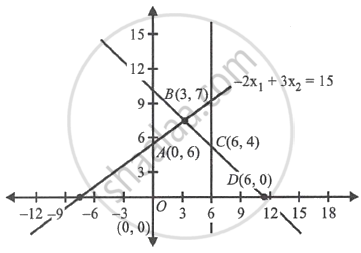Advertisements
Advertisements
Question
The objective function Z = x1 + x2, subject to the constraints are x1 + x2 ≤ 10, – 2x1 + 3x2 ≤ 15, x1 ≤ 6, x1, x2 ≥ 0, has maximum value ______ of the feasible region.
Options
at only one point
at only two points
at every point of the segment joining two points
at every point of the line joining two points equivalent to
Solution
The objective function Z = x1 + x2, subject to the constraints are x1 + x2 ≤ 10, – 2x1 + 3x2 ≤ 15, x1 ≤ 6, x1, x2 ≥ 0, has maximum value at every point of the segment joining two points of the feasible region.
Explanation:
Since, objective function is Z = x1 + x2 and given constraints are
x1 + x2 ≤ 10, – 2x1 + 3x2 ≤ 15, x1 ≤ 6, x1, x2 ≥ 0

Now, the point of intersection oflines x1 + x2 = 10 and – 2x1 + 3x2 = 15 is B(3, 7) and point of intersection of lines x1 = 6 and x1 + x2 = 10 is C(6, 4)
Here, the feasible region is OABCD. The corner points of the feasible region are O(0, 0), A(0, 6), B(3, 7), C(6, 4) and D(6, 0).
| At O(0, 0) | Z = 0 + 0 = 0 |
| At A(0,6) | Z = 0 + 6 = 6 |
| At B(3,7) | Z = 3 + 7 = 10 |
| At C(6,4) | Z = 6 + 4 = 10 |
| At D(6,0) | Z = 6 + 0 = 6 |
Hence, Z is maximum at each point of the segment joining two points B(3, 7) and C(6, 4)
